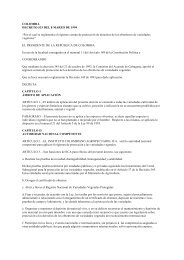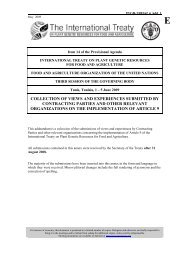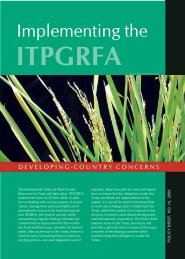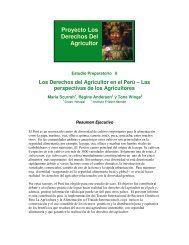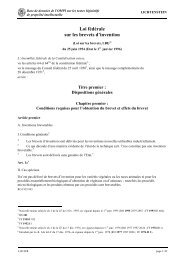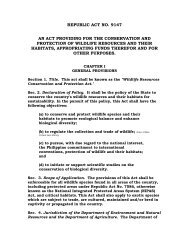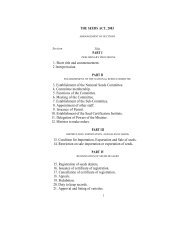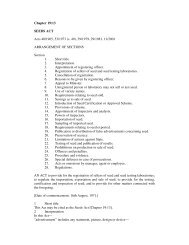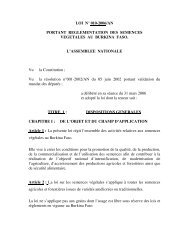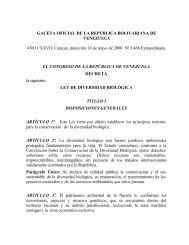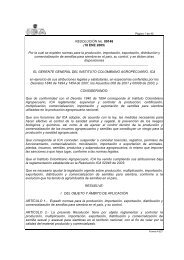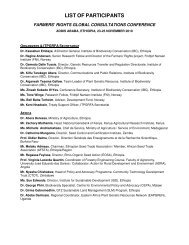Para PDF Tesis con Figuras en Word.p65 - Farmers' Rights website
Para PDF Tesis con Figuras en Word.p65 - Farmers' Rights website
Para PDF Tesis con Figuras en Word.p65 - Farmers' Rights website
Create successful ePaper yourself
Turn your PDF publications into a flip-book with our unique Google optimized e-Paper software.
compare the total in-situ population of native cultivars maintained by farmers in Huancavelica<br />
against a geographically restricted subset of accessions from CIP’s core ex-situ population as<br />
maintained in the g<strong>en</strong>ebank.<br />
2.2 Materials and methods<br />
2.2.1 In-situ collections for characterization<br />
Eight communities following a north-south transect through the departm<strong>en</strong>t of Huancavelica<br />
were selected on the basis of distribution and distance along the transect, tradition of potato<br />
cultivation, ethnicity, and relative distance from major markets or cities (see chapter 1). During<br />
three subsequ<strong>en</strong>t agricultural seasons, farmer and communal potato collections of native potato<br />
cultivars were characterized using differ<strong>en</strong>t tools: ploidy counts, morphological descriptor lists<br />
and molecular markers. Families or communal groups with appreciable diversity were id<strong>en</strong>tified<br />
and seed-tubers of each farmer-recognized cultivar stored in net-bags. Some farmer families<br />
maintained very large cultivar collections and subsets of their total collection were installed in<br />
subsequ<strong>en</strong>t agricultural seasons. Accessions were labeled and on-farm trials with a minimum of<br />
five and a maximum of t<strong>en</strong> plants per accession installed. Field space was provided by the<br />
participating families or groups with prior informed <strong>con</strong>s<strong>en</strong>t and with authorization obtained<br />
during communal assemblies. The in-situ collections were used as the basis for ploidy counts,<br />
botanical species id<strong>en</strong>tification, morphological and molecular (SSR) characterization (table 2.2).<br />
Additionally, two collection trips were undertak<strong>en</strong> in 2005 to search for Solanum phureja in<br />
inter-Andean valleys below 3,400 m altitude. One trip was undertak<strong>en</strong> to the remote eastern<br />
districts of Huachocolpa and Tintay Puncu (Tayacaja province) and one to the low inter-Andean<br />
valley of Lircay following the Totora watershed (Angaraes province).<br />
2.2.2 Ploidy counts and species id<strong>en</strong>tification<br />
Ploidy levels in combination with morphological keys were used to determine the botanical<br />
species to which accessions belonged. Species id<strong>en</strong>tification was double checked in op<strong>en</strong> field<br />
and under gre<strong>en</strong>house <strong>con</strong>ditions using the botanical keys developed by Huamán (1983). Ploidy<br />
was determined by both microscopy and flow cytometry. The microscopy method followed<br />
standard procedures (Ch<strong>en</strong> and Hai, 2005; Watanabe and Orrillo, 1993): a. collection of 0.5-1.0 cm<br />
long root tips betwe<strong>en</strong> 11:20 and 12:00 a.m., b. treatm<strong>en</strong>t of root tips with a solution of Ambush<br />
50EC for the det<strong>en</strong>tion of mitosis in metaphase (incubate root tips in solution with 15 µl stock of<br />
Ambush 50EC in 100 ml H 2<br />
O pH 5.8 for 24 hours at 4ºC; wash 15 minutes with H 2<br />
O pH 5.8), c.<br />
optional fixation (incubate in 3 parts ethanol 96% and 1 part acetic acid at 20ºC for 24 hours;<br />
rinse with ethanol 70% and air dry; store at 4ºC for not longer than 7-10 days), d. hydrolysis<br />
(incubate in 1N HCl at 60ºC for 8-10 minutes, wash for 15 minutes with distilled water), e. staining<br />
(incubate in lacto-propionic orcein for 3 minutes), f. preparation of squash slides, g. microscopy<br />
(actual counting). Flow cytometry was <strong>con</strong>ducted with a Partec® ploidy analyzer through<br />
measurem<strong>en</strong>t of the total DNA <strong>con</strong>t<strong>en</strong>t of nuclei from leaf samples. Ploidy levels were read from<br />
real time DNA histograms.<br />
2.2.3 Morphological characterization<br />
The morphological diversity of native cultivar collections was characterized using CIP’s formal<br />
descriptor list and color card (Gómez, 2000; Huamán and Gómez, 1994). This formal list <strong>con</strong>sists<br />
of 17 morphological descriptors with a total of 32 morphological character states, 18 of which<br />
are <strong>con</strong>sidered to be <strong>en</strong>vironm<strong>en</strong>tally stable (app<strong>en</strong>dix I). Similarity analysis, d<strong>en</strong>drogram<br />
<strong>con</strong>struction, coph<strong>en</strong>etic analysis and matrix correlations calculations (Mantel tests) were<br />
<strong>con</strong>ducted. A standardized similarity analysis with an average taxonomic distance coeffici<strong>en</strong>t<br />
38 Potato diversity at height: Multiple dim<strong>en</strong>sions of farmer-driv<strong>en</strong> in-situ <strong>con</strong>servation in the Andes



